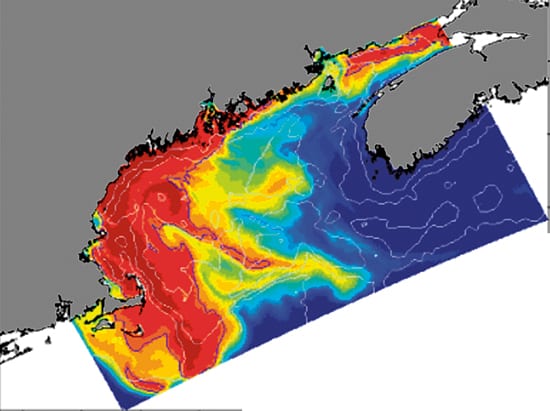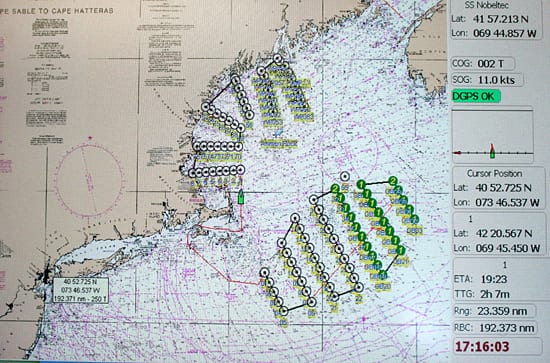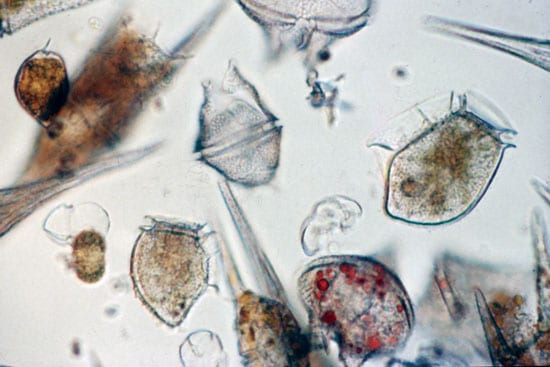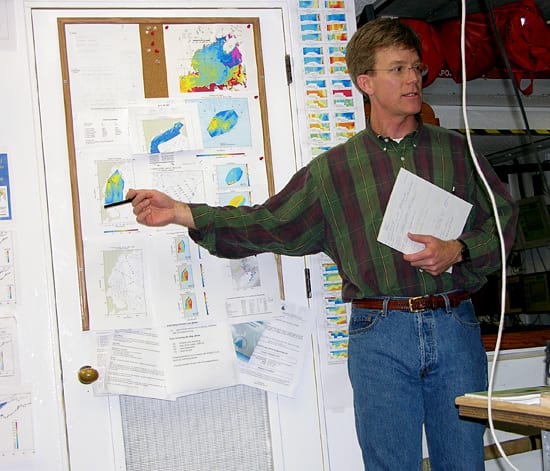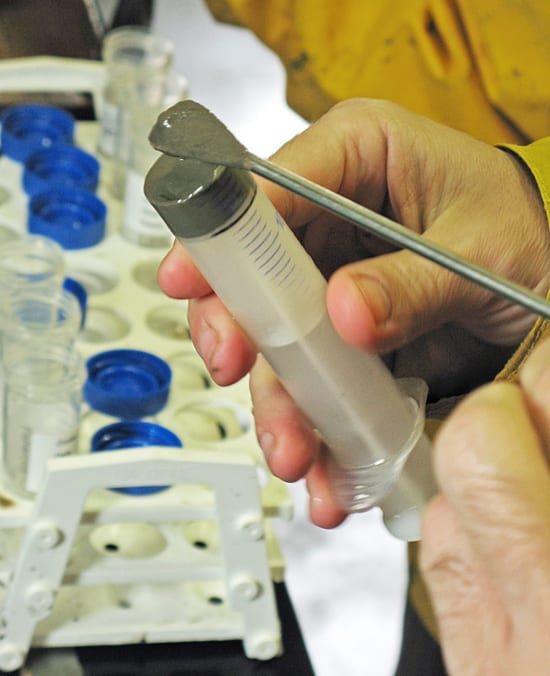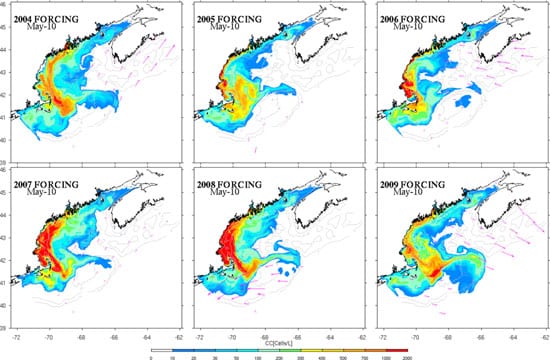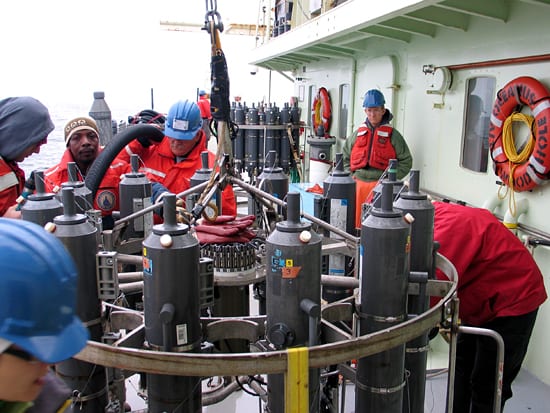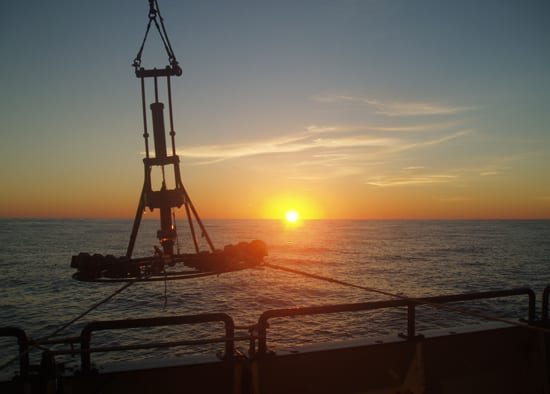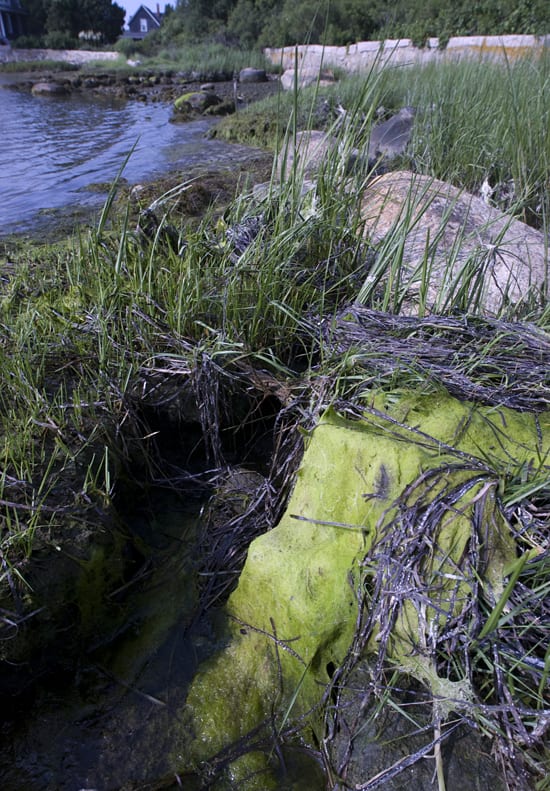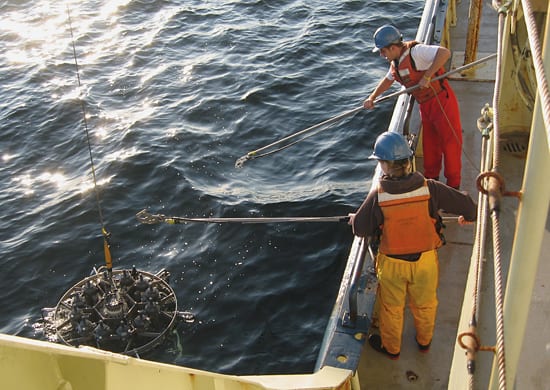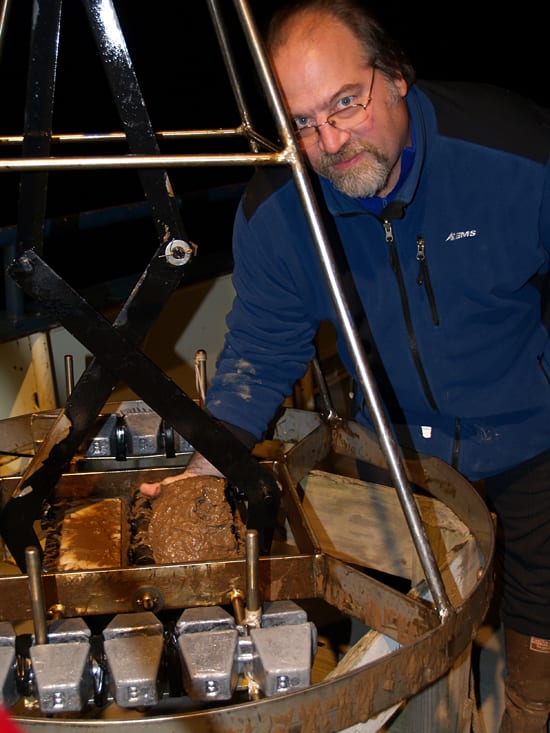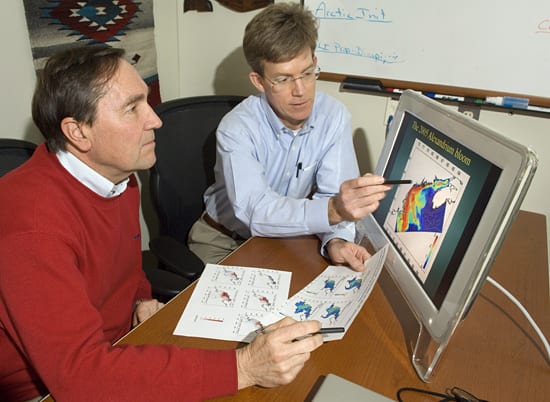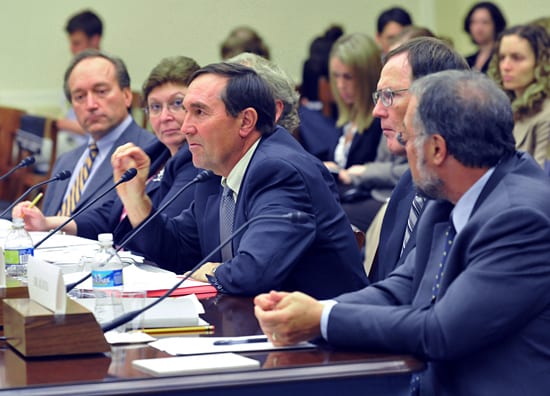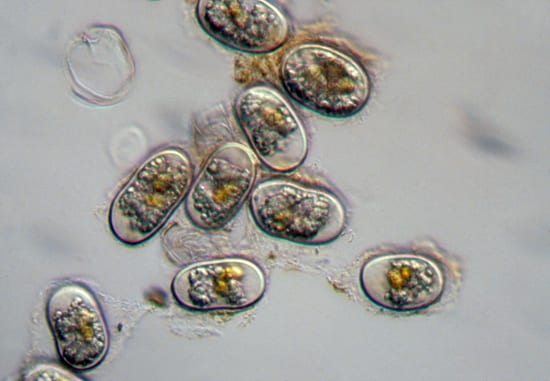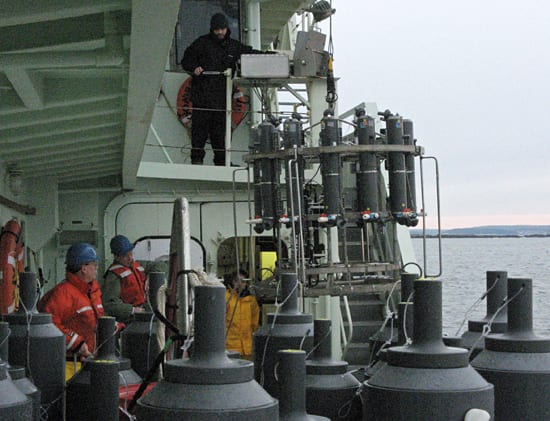Harmful Algae & Red Tide Research
- WHOI scientists Dennis McGillicuddy and Ruoying He created a computer simulation of the historic 2005 toxic algae bloom in New England. Red denotes high algae concentrations; blue the lowest. Algal cells germinated from cyst beds in the Bay of Fundy and along the Maine coast. They were swept south and west by currents. McGillicuddy and He entered a range of factors into their model: the speeds and directions of ocean currents, water temperature and salinity, winds, surface heat exchanges, tides, river runoff, and the distribution and behavior of cells in the water and in seafloor sediments. (Data visualization by Ruoying He and Dennis McGillicuddy, Woods Hole Oceanographic Institution)
- A computer screen capture shows a map of the sampling locations for the research crew sailing on the RV Oceanus in May and June 2008 to study harmful algal blooms in New England waters. The "MapTech" software program allows the researchers to plot—and later readjust—exactly where they want to take samples of seawater and sediments. It also allows the ship crew to plot the shortest path from point A to B. Black dots show the sampling locations chosen before the cruise, while green dots show locations that were added after the science party decided to search for the edges of the ocean bloom of Alexandrium. (Photo by Bibiana Gomez-Crespo, Woods Hole Oceanographic Institution)
- Harmful algal blooms are caused by species of tiny plants—phytoplankton—that produce potent chemical toxins. Fueled by periodic abundances of nutrients in the ocean, these algae multiply and proliferate until they can cover tens to hundreds of miles of coastal ocean. (Photo by Don Anderson, Woods Hole Oceanographic Institution)
- On the research vessel Oceanus in May 2008, the backside of a hatch to the lower decks serves as the bulletin board and presentation backdrop for oceanographer Dennis McGillicuddy as he briefs the science team. In the final science meeting of a cruise to study harmful algal blooms in New England waters, McGillicuddy points out the concentrations of Alexandrium fundyense that the group observed in the western Gulf of Maine—four times higher than has ever been measured in the region at that time of year. The data lent credence to earlier predictions of a potentially large bloom season. The science team departs again today to continue their observations, which aid both this year's coastal resource management and long-term efforts to model and predict such blooms. (Photo by Erin Dupuis, Woods Hole Oceanographic Institution)
- Postdoctoral fellow Luciano Fernandes of the WHOI Biology Department handles a mud sample plucked from the Gulf of Maine during an October 2007 cruise on the research vessel Oceanus. As part of the five-year Gulf of Maine toxicity experiment (GOMTOX), researchers from WHOI and several other institutions are observing and modeling the patterns and mechanisms that lead to blooms of Alexandrium fundyense, a harmful form of algae that can sicken humans who eat tainted shellfish. The sediment samples allow researchers to assess how many seeds, or cysts, are residing in the mud for potential blooms in the following year. (Photo by Alexander Dorsk, Woods Hole Oceanographic Institution)
- These computer simulation snapshots show projected Alexandrium fundyense cell concentrations that might be produced under six different weather and oceanographic scenarios representative of 2004 through 2009. All simulations were initiated using the latest 2009 cyst map. The simulations incorporate sunlight, river runoff, and various wind and current patterns to predict the intensity and location of a bloom. These images do not show the highest anticipated cell concentrations, but rather the concentrations and distributions on the same day in May. This approach provides an ensemble forecast that includes years that had highly variable meteorological conditions. In all scenarios, the Alexandrium cell concentrations are high relative to past bloom simulations using different cyst maps to initiate the runs. (Dennis McGillicuddy, Woods Hole Oceanographic Institution; Ruoying He, North Carolina State University)
- Researchers aboard the R/V Oceanus affix a hose to the CTD rosette (frame) to collect large-volume water samples with a pump system during a May 2008 expedition in New England waters. Researchers from WHOI, University of Massachusetts–Dartmouth (UMD), and the University of Maine were observing hydrography and sampling for signs of Alexandrium fundyense, a harmful species of algae that can cause paralytic shellfish poisoning in humans who consume tainted shellfish. Oceanographer Jefferson Turner of UMD (background with blue hat and black hose) uses the large samples to measure the accumulation of paralytic shellfish poisoning toxins in the planktonic food web. Clockwise from the foreground: Bibiana Crespo, Alex Dorsk, Clindor Cacho, Turner, and Dennis McGillicuddy. (Photo by Luciano Fernandes, Woods Hole Oceanographic Institution)
- A sediment corer dangles in the evening sun before being lowered to the seafloor in the Gulf of Maine. Researchers from WHOI, NOAA, and several institutions sampled the muck and sand for signs of cysts left behind by the harmful algae Alexandrium as the autumn chilled the waters off New England. The cysts lie dormantin the sediment until springtime conditions are favorable for blooming. (Photo by Linda Ahearn O'Higgins, National Oceanic and Atomospheric Administration)
- What looks like a lime-green sheet of paper is actually a mat of algae. Harmful algal blooms, like this one in West Falmouth Harbor, Mass., can occur in coastal waters as a result of excess nutrients from septic systems, nearby sewage treatment plants and agricultural runoff. (Photo by Tom Kleindinst, Woods Hole Oceanographic Institution)
- MIT/WHOI Joint Program graduate student Christie Wood (foreground) and postdoctoral investigator Alfredo Aretxabaleta prepare to recover the conductivity-temperature-depth rosette during the NOAA Rapid Response cruise to study red tide in June 2006. (Photo by Dennis Evangelista, Woods Hole Oceanographic Institution)
- WHOI Research Associate Bruce Keafer digs into a pile of muddy sediment from the bottom of the Gulf of Maine. Keafer and colleagues worked in that North Atlantic basin in November 2006 to detect the amount of cysts that were left behind by the harmful algae Alexandrium fundyense at the end of the growing season. Those cysts lie dormant on the seafloor, seeding the sediments for future growing seasons, which usually begin in the first week of April. (Photo by Patrick Rowe, Woods Hole Oceanographic Institution)
- WHOI biologist Don Anderson (left) and oceanographer Dennis McGillicuddy review the results of a computer simulation of the 2008 season for Alexandrium fundyense—a toxic form of algae—in New England waters. A combination of abundant beds of algal seeds and excess winter precipitation in the Northeast U.S. have set the stage for a potentially big bloom. (Photo by Tom Kleindinst, Woods Hole Oceanographic Institution)
- Don Anderson (center), a senior scientist in the WHOI Biology Department, testified in September 2009 before the U.S. House of Representatives Committee on Science and Technology, which is drafting legislation to prevent and control harmful algal blooms and hypoxia (low dissolved oxygen). (Photo by Photo-Op for Woods Hole Oceanographic Institution)
- Harmful algal bloom (HAB) cells shown under a microscope. This organism swims in the water, and divides again and again to form a “bloom” or red tide, but it also produces dormant cells or cysts that fall to the ocean bottom at the end of these blooms. (Photo by Don Anderson, Woods Hole Oceanographic Institution)
- Researchers Jefferson Turner of UMass Dartmouth, left, foreground, Dennis McGillicuddy of WHOI (green jacket), and winch operator John Gaylord of WHOI, above, deploy a CTD rosette system on R/V Oceanus to measure water properties and collect samples during a voyage studying a harmful algal bloom, or “Red Tide," in the Gulf of Maine. Researcher Stacy Lee of Northeastern University (yellow jacket) looks on. (Photo by Alexander Dorsk, Woods Hole Oceanographic Institution)
SEARCH RELATED TOPICS: Harmful Algae & Red Tides
Image and Visual Licensing
WHOI copyright digital assets (stills and video) contained on this website can be licensed for non-commercial use upon request and approval. Please contact WHOI Digital Assets at images@whoi.edu or (508) 289-2647.
